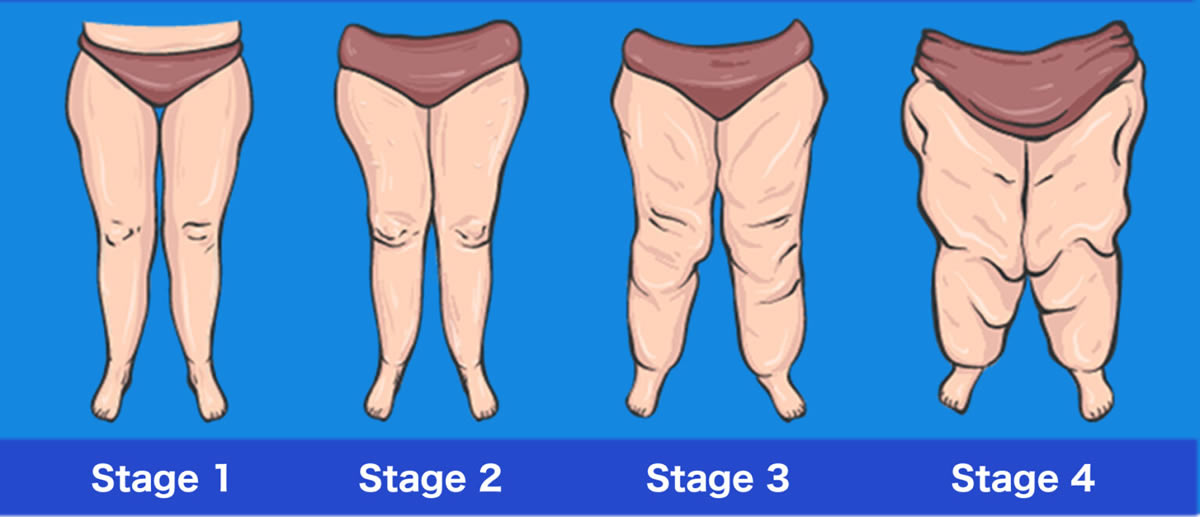Lipedema is a chronic condition that primarily affects women and is characterized by the abnormal accumulation of fat in the legs, hips, and sometimes arms. This fat is typically distributed symmetrically and can cause pain, tenderness, and swelling in the affected areas. Lipedema is often misdiagnosed or mistaken for obesity, but it is a distinct condition that is not caused by lifestyle factors such as overeating or lack of exercise.
The exact cause of lipedema is not known, but it is believed to be related to hormonal changes, genetics, or other factors that affect the lymphatic system. Lipedema can be progressive and can lead to complications such as lymphedema, skin changes, and mobility issues. While there is no cure for lipedema, treatments such as compression therapy, manual lymphatic drainage, and liposuction can help manage symptoms and improve quality of life.

What is Lipedema Surgery Options
Lipedema surgery options include liposuction and lymphatic sparing liposuction. In the case of lipedema, liposuction is used to remove the excess fat in the affected areas, such as the legs or arms. Liposuction for lipedema is typically done under general anesthesia and may involve multiple sessions to achieve the desired results.
Lymphatic sparing liposuction is a specialized form of liposuction that is designed to protect the lymphatic vessels that are often affected in lipedema. This procedure is performed by a specialized surgeon who has experience with lymphatic disorders. Lymphatic sparing liposuction can help to reduce pain and swelling in the affected areas and may also improve mobility and quality of life.
It’s important to note that surgery is not the first line of treatment for lipedema and should only be considered after other conservative treatments have been attempted and found to be ineffective. Surgery also carries risks and should only be performed by a qualified surgeon with experience in treating lipedema. It’s important to discuss all treatment options with a healthcare provider to determine the best approach for an individual’s specific needs.
Preparation for Lipedema Surgery?
If you’re considering lipedema surgery, there are several steps you can take to prepare for the procedure and improve your chances of a successful outcome. Here are some common preparations for lipedema surgery:
- Consult with a qualified surgeon: It’s important to choose a surgeon who is experienced in treating lipedema and who has a good track record of successful outcomes. Ask your surgeon about their experience with lipedema surgery and what to expect before, during, and after the procedure.
- Follow preoperative instructions: Your surgeon will provide you with specific instructions on how to prepare for the surgery, such as fasting requirements and medication restrictions. Follow these instructions closely to avoid complications during the procedure.
- Arrange for postoperative care: Lipedema surgery can be a significant procedure, and you may need assistance with daily activities and care during the recovery period. Make arrangements for postoperative care, such as arranging for someone to help you with transportation, meal preparation, and other tasks.
- Manage your health: Maintaining good health before the surgery can help improve your recovery and outcomes. This may include managing chronic conditions such as diabetes or high blood pressure and avoiding habits such as smoking that can interfere with healing.
- Plan for downtime: Recovery from lipedema surgery can take several weeks or longer, depending on the extent of the procedure. Plan for downtime and avoid strenuous activities, lifting heavy objects, or other activities that could put strain on the surgical area.
By following these preparations, you can help ensure a smooth and successful experience with lipedema surgery. Be sure to discuss any concerns or questions with your surgeon or healthcare provider.

Recovery from lipedema surgery?
Recovery from lipedema surgery can vary depending on the extent of the procedure and the individual’s overall health. Here are some general guidelines and tips for a successful recovery:
- Follow postoperative instructions: Your surgeon will provide you with specific instructions on how to care for the surgical site, including changing bandages, avoiding certain activities, and taking medications. Follow these instructions closely to avoid complications and promote healing.
- Wear compression garments: Compression garments can help reduce swelling and promote healing after lipedema surgery. Your surgeon may recommend wearing compression garments for several weeks or months after the procedure.
- Manage pain and discomfort: Pain and discomfort are common after lipedema surgery. Your surgeon may prescribe pain medication or recommend over-the-counter pain relief options to help manage these symptoms.
- Monitor for complications: While complications are rare, it’s important to monitor the surgical site for signs of infection, bleeding, or other issues. Contact your surgeon if you experience persistent pain, swelling, or other symptoms.
- Take it easy: Recovery from lipedema surgery can take several weeks or longer, depending on the extent of the procedure. It’s important to avoid strenuous activities, lifting heavy objects, or other activities that could put strain on the surgical area.
- Attend follow-up appointments: Follow-up appointments with your surgeon are important to monitor your progress and ensure that your recovery is proceeding as planned. Attend all scheduled appointments and report any concerns or issues to your surgeon.
Overall, recovery from lipedema surgery can be a gradual process, but with proper care and attention, most individuals can expect to return to normal activities within a few weeks to months after the procedure. Be sure to follow all postoperative instructions closely and contact your surgeon with any concerns or questions.
Risk and complications of lipedema surgery?
Like all surgical procedures, lipedema surgery carries some risks and potential complications. Here are some of the most common risks and complications associated with lipedema surgery:
- Infection: Any surgical procedure carries a risk of infection, which can be serious if left untreated.
- Bleeding: There may be some bleeding during and after the surgery, which can be managed with appropriate measures.
- Swelling and bruising: Swelling and bruising are common after lipedema surgery, but these usually resolve on their own.
- Blood clots: Following surgery, blood clots can develop in the legs and can be fatal if they spread to the lungs.
- Numbness and tingling: Some individuals may experience numbness or tingling in the affected areas after surgery, which can be temporary or permanent.
- Uneven or lumpy appearance: Lipedema surgery can be complex and challenging, and it’s possible to have an uneven or lumpy appearance after the procedure.
- Need for additional procedures: Some individuals may require additional procedures, such as touch-up surgeries, to achieve the desired results.
- Complications with anesthesia: General anesthesia carries risks, including respiratory complications, allergic reactions, and heart problems.
It’s important to discuss the potential risks and complications of lipedema surgery with your surgeon before the procedure to understand the potential risks and how to manage them. Your surgeon will also discuss how to minimize the risks, such as by choosing a surgeon with experience in lipedema surgery, following all pre- and post-operative instructions, and monitoring for signs of complications.
